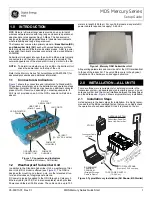
Page 39
FT
DX
5000 O
PERATING
M
ANUAL
If you press the
[
BAND/MCH
] but-
ton briefly, the button
glows red, and the
[
C L A R
(
V F O - B
)]
knob may be used as
the band selection
knob.
7. Press the [
(
DOWN
)]/[
(
UP
)] buttons to tune the
VFO-A frequency in 1 MHz
steps.
A
DVICE
:::::
You may change the tuning step to 100 kHz via Menu
item “
145 TUN MHz SEL
”. See page 133.
8. Move the [
ANT 1-4
] button up or down to select the
appropriate antenna for the band in use. Alternatively,
you may also press the [
RX ANT
] button to select the
receive antenna, if one is con-
nected. Up to four TX/RX anten-
nas and one RX-only antenna may
be connected.
A
DVICE
:::::
Your antenna selection is “remembered” (in con-
junction with the frequency and mode) in the VFO
register in use, when you choose that particular
antenna.
When VFO-A and VFO-B are switched to the same
antenna jack, VFO-B receiver will be automatically
connected to the RX ANT jack.
When both VFO-A and VFO-B are switched to the
RX ANT, the signal output from the RX OUT jack
is connected to the VFO-A receiver
.
9. Press the appropriate [
MODE
]
button to select the desired op-
erating mode.
A
DVICE
:::::
By convention in the Ama-
teur bands, LSB is used on
the 7 MHz and lower bands
(with the exception of 60 meters), while USB is
utilized on the 14 MHz and higher bands.
When changing modes from SSB to CW, you will
observe a frequency shift on the display. This shift
represents the BFO offset between the “zero beat”
frequency and the audible CW pitch (tone) you can
hear (the pitch is programmed by the [
PITCH
]
knob), even though the actual tone that you hear is
not changing. If you do not want this frequency shift
to appear when changing modes, you may change
the BFO offset setting in Menu item “
066 A1A FRQ
DISP
”, described on page 127.
When operating on the FM mode
in the VFO-A, rotate the (
VFO-
A
)[
SQL
] (Squelch) knob clock-
wise just to the point where the
background noise is silenced. This
is the point of maximum sensitivity to weak sig-
nals. Excessive advancement of the
Squelch knob will degrade the abil-
ity of the receiver to detect weak
signals. Adjustment of the VFO-B
Squelch is accomplished using the
(
VFO-B
)[
SQL
] knob.
10. Rotate the Main Tuning Dial knob to tune around the
band, and begin normal operation.
A
DVICE
:::::
Clockwise rotation of the Main Tuning Dial knob
increases the operating frequency, one “step” of the
synthesizer at a time; similarly, counter-clockwise
rotation of the Main Tuning Dial knob will decrease
the frequency.
A “normal” and a “fast”
step choice is available on
each operating mode.
Pressing the [
FAST
] but-
ton engages the “Fast”
tuning selection.
B
ASIC
O
PERATION
:
R
ECEIVING
ON
A
MATEUR
B
ANDS
O
PERATING
M
ODE
1
STEP
1
DIAL
ROTATION
LSB, USB, CW,
10Hz
10kHz
RTTY, PKT(LSB)
[100Hz]
[100kHz]
AM, FM, PKT(FM)
100Hz [1kHz]
100kHz [1MHz]
[ ] : [
FAST
] switch set to “ON”
It is possible to set the frequency dial rotation steps
separately, solely for CW mode operation, using
Menu items “
143 TUN DIAL STP
”, and “
144 TUN
CW FINE
”. See page 133.
If you want to navigate frequency change quickly,
there are several techniques available:
Direct keyboard entry of the frequency (see page
49).
Use of the microphone [
UP
]/[
DWN
] scanning
keys, if your microphone is so equipped (see
page 49).
ANTENNA SWITCH
(VFO-A)
ANTENNA SWITCH
(VFO-B)
RX ANTENNA SWITCH
(VFO-B)
RX ANTENNA SWITCH
(VFO-A)
TX/RX RELAY
Transmitter
Section
VFO-A
Receiver
VFO-B
Receiver
BPF
ANT “1”
ANT “3”
ANT “2”
ANT “4”
RX ANT
RX OUT
Divider
SEPARATE
SEPARATE
A
NTENNA
C
IRCUIT
D
IAGRAM
















































